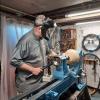Matt,
Here is an hour and a half video on holding wood on a lathe. Using a chuck starts at about the one hour mark but I seem to remember the whole video being worth watching. Been a few years.
One thing that hasn't got much attention is your choice of woods. Some woods are much more inclined to crack and split so just spinning them can be enough to break them. If possible start with plain wood that isn't prone to splitting.
I have used tenons and recesses and don't have a real strong preference. Either will work fine cut properly, either one can cause trouble if they aren't cut properly. Another issue is overtightening the chuck. You may be damaging the wood before you even start trying to hollow.
I did about the same as you sounds like, I broke a lot of blanks off of my lathe when I started out. A combination of a very poor choice of wood and pretty much all the errors you can make chucking. I notice that you are breaking the wood off of the lathe hollowing which usually has you outside the primary line of fire but it is dangerous anytime you have the wood making an unplanned departure from the lathe. Do your homework and very possibly modify the way you are hollowing. A major catch can cause a trainwreck with a perfectly secured bowl.
Sometimes we have to back off and do some homework instead of plunging blindly ahead on the lathe like I did for awhile. I think you are finding out the same thing, therefore this thread. Take some time to regroup, read, and watch video. Wood turning is fairly safe going about it correctly, pretty dangerous when we blunder into it like I did.
Hu
https://www.youtube.com/watch?v=aUXil-5dEeo




 Reply With Quote
Reply With Quote






